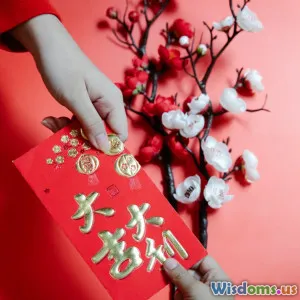
The Art of Gift Giving in Various Cultures
9 min read Explore the rich traditions of gift giving across cultures and learn how this art shapes connections around the world. (0 Reviews)
The Art of Gift Giving in Various Cultures
Gift giving is more than a simple exchange of objects—it is a deeply woven social ritual that reflects history, values, and relationships. Across the globe, the art of giving embodies complex customs and meanings that differ from one culture to another. Whether you are a seasoned traveler, a culturally curious individual, or someone interested in making your gifts more meaningful, understanding these traditions can enrich your experience and foster stronger connections.
Introduction: The Universal Language of Gift Giving
Gift giving is an ancient practice present in virtually every society. Anthropologists argue it is fundamental to human bonding, establishing trust, respect, and reciprocity. Anthropologist Marcel Mauss, in his work "The Gift" (1925), argued that gifts are never truly free—they create social ties and obligations. However, while the impulse to give is near universal, what constitutes an appropriate gift, how it is presented, and the etiquette involved varies dramatically.
Recognizing these differences is especially crucial for travelers and international businesspeople who might unwittingly offend by overlooking local customs or missing vital nuances.
Gift Giving in East Asia: Symbolism and Etiquette
China: Meaning Behind Colors and Numbers
In Chinese culture, gift giving is steeped in symbolism and governed by intricate etiquette. The color red, for instance, is associated with luck and happiness, so red envelopes (hongbao) filled with money are popular gifts during celebrations like Lunar New Year and weddings. Conversely, white and black are generally avoided as gift wrappings since they are linked with mourning.
Numbers also carry significance:
- The number 8 symbolizes prosperity and good fortune, so gift amounts or packaging favor eights.
- The number 4, sounding like the word for death, is avoided.
Additionally, gifts are often presented with two hands—a gesture of respect—and receivers may initially refuse a gift out of modesty, requiring insistence as a form of politeness.
Japan: Omotenashi and Thoughtful Presentation
Japan's gift culture, shaped by the concept of "omotenashi" (selfless hospitality), emphasizes the thought behind the gift and the elegance of its presentation. "Omiyage," or souvenirs taken from trips, are customarily shared with co-workers and friends to show gratitude and maintain social bonds.
An often-cited example is the giving of exquisitely wrapped boxes of sweets during the "Ochugen" (mid-year) and "Oseibo" (year-end) seasons. The wrapping and packaging are as important as the gift inside, reflecting the giver's respect and careful attention.
Reciprocity is expected but subtly managed, and direct refusal is avoided to maintain harmony.
South Asia: Gift Giving as a Social Contract
India: Gifts in Religious and Social Contexts
In India, gift giving intertwines with spiritual beliefs and social hierarchies. Religious gifts, such as offerings at temples or gifts during festivals like Diwali, are common and believed to bring blessings.
Social gift exchanges often recognize relationships and status. For example, presenting sweets or dry fruits when visiting someone's home is customary.
However, there are notable taboos:
- Gifts of leather to Hindus are often avoided due to the sacredness of cows.
- Clocks or handkerchiefs may be interpreted as symbols of separation or bad luck.
Presentation is crucial—using the right hand for gifting (or both hands) and avoiding wrapping in black are standard customs.
Middle East: Generosity and Hospitality
In many Middle Eastern cultures, hospitality and generosity are cornerstones of gift giving. When visiting someone’s home, guests are often met with lavish gifts like sweets, coffee, or exquisitely wrapped nuts.
Points to consider include:
- Gifts are often wrapped beautifully but never in white paper, which can signify mourning.
- Despite reciprocal exchanges, modest refusal before acceptance demonstrates humility.
This ritualistic generosity reinforces deep social ties and mutual respect.
Western Cultures: Informality and Personalization
Europe and the Americas: Variability and Trends
In much of Europe and the Americas, gift giving tends to be more informal, but it still reflects social nuances. There is a growing emphasis on personalization and sustainability.
For example, in the United States, handmade or experience-based gifts (concert tickets, a cooking class) are increasingly popular, reflecting a desire for meaningful, less materialistic exchanges.
Western cultures are generally less rigid about colors or numbers but often observe practical etiquettes, such as not opening gifts immediately in formal business settings.
Special Occasions and Holidays
Specific traditions such as Christmas, birthdays, and weddings dictate gift giving norms:
- In the UK, the etiquette of unwrapping gifts during Christmas morning is a cherished ritual.
- In Mexico, "Las Posadas" and "Quinceañera" celebrations involve gift exchanges that signify community support.
Understanding these can help travelers join in festive moods respectfully.
Case Study: Gift Giving in Africa
Africa's vast cultural tapestry reveals diverse approaches. In many communities in Kenya, gifts are used to establish or nurture relationships and are often symbolic of respect.
For instance, Maasai tribespeople might present handicrafts or elaborate beadwork when welcoming guests or as a form of negotiation.
In West Africa, kola nuts are a recurring traditional gift symbolizing hospitality and respect, often used in ceremonies and negotiations. Refusal to accept kola nuts might be seen as offensive.
Practical Tips for Travelers and Global Citizens
-
Research First: Understanding basic gift-giving taboos and preferences of your destination or cultural counterpart prevents faux pas.
-
Presentation Matters: Invest time in wrapping, as this often communicates respect and thoughtfulness.
-
Mind the Occasion: Tailoring the gift to occasions—religious, social, or business—is essential.
-
Be Sensitive to Taboos: Avoid gifts that could be misunderstood or considered offensive, such as leather in certain cultures or clocks in China.
-
Reciprocity and Etiquette: Be prepared for modest refusals or expectations of reciprocation.
Conclusion: The Gift as a Bridge Across Cultures
Gift giving transcends material value—it is a language rich in symbolism, tradition, and emotion. Recognizing how this art manifests differently across cultures not only enhances your travel and interpersonal experience but also deepens your appreciation of human connection.
As author and cultural professor Erin Meyer notes, "When you give thoughtfully, you’re speaking the language of respect, curiosity, and empathy."
Embrace the nuanced customs, and gifts become more than objects—they become dialogues, bridges, and memories.
References:
- Mauss, M. (1925). The Gift: Forms and Functions of Exchange in Archaic Societies.
- Meyer, E. (2014). The Culture Map: Breaking Through the Invisible Boundaries of Global Business.
- Personal interviews and reports from cultural experts and travelers.
Rate the Post
User Reviews
Popular Posts





















